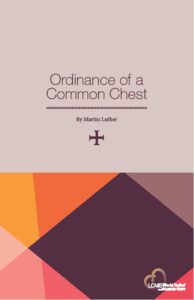 The Lord be with you
The Lord be with you
The Reformation brought with it a great deal of social upheaval. The lands that embraced the Reformation had to reexamine many aspects of their social lives, which had been under sway of Rome for centuries. Some of those places that needed to be considered were how to address the poor of the area, how to pay for ministers and school teachers, what to do with church properties and, in general, how the priesthood of believers and the Gospel impacted such things. The city of Leising developed an agreement among their citizens which became a model for other cities. Martin Luther published it and provided a preface. In reading these documents, one begins to appreciate, not only the desire of Reformation Christians to live in love towards all, but also the challenges such a desire presented for them.
This “Mercy Essay” is largely a representation of what can be found in the American Edition of Luther’s Works, volume 45. This booklet is divided into four parts. Part one is the Forward by Matthew Harrison. It is a wonderful, short, treatment of the issues present at the time in reference to the place of Christian Mercy in daily life. Part two is the introduction of the Ordinance that is provided in Luther’s Works. This gives the particulars of the issues Leising faced and the history behind them. Part three is the Preface Martin Luther wrote for the publication of the Ordinance during his lifetime. In it he not only expresses his hope that it will become a model for other cities, but also a warning or two about things that might go wrong. Part four is the actual ordinance. It covers a wide range of topics like care for monks, priest, etc. who did not join the Reformation, care for beggars, teachers, the sick, and so on. They made decisions on how to gather funds for this work and who would be in charge.
For me, the slowest reading was the actual Ordinance as it deals with issues that we have never faced in America. For sure, there are principles underlying these regulations that continue to have value, but I don’t need to know when their quarterly meetings were scheduled. These rules take up 19 of the 37 pages. If you are a history buff, you will find the Introduction fascinating. As I already said, the Forward by Matthew Harrison is excellent and worth reading, even if you read no farther. Luther’s Preface is written in his typical lively style. One of the reasons he gives for having the Ordinance published is to absolve himself from claims by others that he doesn’t care for the poor.
Matthew Harrison ends his Forward with, “The church has a corporate life of mercy … That corporate life of care as the body of Christ is worth the investment of time and thought. To that end, we give you what follows.”
May the Lord of the Church enable us to seriously invest our time and thought in how we can live our “corporate life of mercy.” May this booklet aid in this effort.
